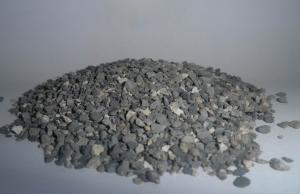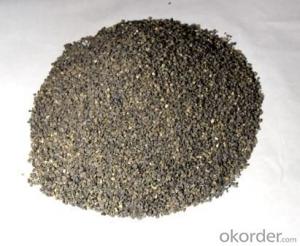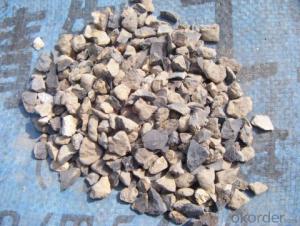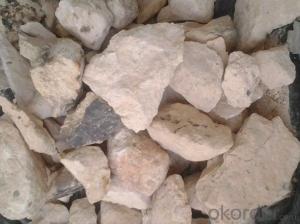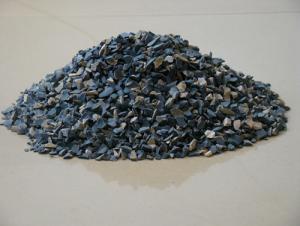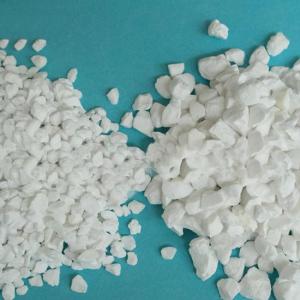Raw Materials for Refractory - Rotary Kiln Calcined Bauxite for Refractory Bricks
- Loading Port:
- China main port
- Payment Terms:
- TT OR LC
- Min Order Qty:
- 25 m.t.
- Supply Capability:
- 2000 m.t./month
OKorder Service Pledge
OKorder Financial Service
You Might Also Like
Pack
| Packaging Details: | 1.25kg/Bag 2.As your demands |
| Delivery Detail: | 30 days after down deposit |
Al2O3 85% Rotary Kiln Calcined Bauxite for Refractory Castables
Specifications&Data
What is the details of our steel fiber reinforced refractory castable?
Steel fiber reinforced refractory castable is a special castable which is added steel fiber into the castable,can improve the toughness,mechanical strength,thermal shock resistance and spalling resistance.
What is the Feature of Our steel fiber reinforced refractory castable?
1.High mechanical strength,
2.Good thermal shock resistance,
3.Good toughness and anti-stripping,
4.High refractoriness,
5.Tiny linear variation,no cracking,
6.Resistant to scour and erosion,
7.Good volume stability under high temperature.
What is the Applications of our steel fiber reinforced refractory castable?
Steel fiber reinforced refractory castable is mainly used in heat treatment furnace,heating furnace,soaking pit furnace,tundish slag dam weir,seconclary refining and the catalytic cracking unit etc key part of kiln furnace and thermal equipment.
What is the Technique Data of our steel fiber reinforced refractory castable?

Company Information
CNBM International Corporation (CNBM International) is the most important trading platform of CNBM Group Corporation, a state-owned company under the direct supervision of State-owned Assets Supervision and Administration Commission of the State Council.
Since 2004, the trading volume of CNBM International has been doubled in 5 successive years owing to the support of superior corporations and effort of all staff. Meanwhile, we have established strategic partnerships with hundreds of domestic manufacturers and sound business relations with clients from over 120 countries. Currently, we have wholly-owned overseas subsidiaries and branches in 5 countries with a view to realize localization, which also represents an essential progress in our globalization target.
In line with the business, CNBM International launched E-business platform Okorder.com.
- Q: What are unshaped fire-resisitance materials?
- Refractory castable, refractory plastic material, usually classified according to construction and manufacture method, unfired bricks precast block, refractory pressed into material, refractory cast material, refractory coating, refractory ramming material there are many classification methods
- Q: What is the principal part of silicious refractory material
- lightweight silica bricks, product with fused quartz, the silicon?dioxide content is generally greater than 93%, including silica?brick silicious refractory SiO2 as a main component of refractory products
- Q: I want to consult the fire resistant level standards of external wall thermal insulation materials.
- 1, The building with the height larger than or equal to 100m, should have the A-level combustion performance. 2, The thermal insulation material of the building, with a height larger than or equal 60m and less than 100m, should not be less than the level B2 combustion performance. When using the level B2 insulation material, each level should set horizonal fire barrier zone. 3, The thermal insulation material of the building, with a height larger than or equal to 24m and less than 100m, should not be less than the level B2 combustion performance. When using the level B2 insulation material, each two levels should set horizonal fire barrier zone. 4, The thermal insulation material of the building, with a height less than 24m, should not be less than the level B2 combustion performance. When using the level B2 insulation material, each three levels should set horizonal fire barrier zone. I hope my answer will help you. Thank you!
- Q: How to use fireclay?
- Fire-resistant adhesive material is needed, its effect equals to the cement. Cement will certainly do.
- Q: Who knows the classifications of magnesia refractory?
- They can be devided into two major categories of fettling magnesite grain and magnesite products. They can be divided into fettling magnesite grain, magnesia?brick, magnesia-silica brick, magnesia-alumina brick, magnesium-calcium brick, magnesia-carbon brick and other varieties according to the chemical compositions and purposes Its performance is greatly affected by CaO / SiO2 ratio and impurities. The load softening point and thermal shock resistance of high purity magnesia brick are much higher than those of the general magnesia bricks. It has high refractoriness and good resistance for alkaline slag and iron slag, which is an important kind of advanced refractory material. Magnesia products are mainly produced by sintering, and sintering temperature is generally between 1500 ~ 1800 ℃. Besides, chemical binder can be added to make unburned?bricks and unshaped refractories. Mainly used in open hearth furnace, electric furnace, oxidation converter, non-ferrous metal metallurgy furnace, cement kiln and calcining kiln for basic refractory.
- Q: What's the classification of flameproof glass, the refractory time of fireproofing glass.
- Classify according to the structure, fireproof?performance and fire endurance of fireproofing glass. Classify according to the structure: Composite fireproofing glass (FFB) and monolithic fireproofing glass, classify according to fire resistance: thermal insulation fire-resistant glass(class A) and non-thermal insulation fire-resistant glass (class C);classify it into 5 levels according to fire endurance: 0.5 h, 1.00 h,1.50h, 2.00h, 3.00h.
- Q: how is the high-temperature flame-retardant fibre board?
- The market is mainly divided into three kind of fiber. Density fiberboard, medium density fiberboard, high density fiberboard. Density fiberboard: It is rolled timber sheet made of wood shaving material produced by timber or non timber fiber that is added with or without glue or auxiliary material. A density of less than 450 kg / cubic meter, the larger fiber particles, the internal structure is not homogeneous, relatively lack of strength, lighter weight. MDF: use wood fiber or other plant fiber as material, added with glue. A sheet pressed at high temperature and pressure. A density between 450-880 kg / cubic meter, fiber particles is moderate, well proportioned internal structure, greater strength, moderate weight. HDF: Use wood fiber or other plant fiber as material, added with glue. A sheet pressed at high temperature and pressure. Its density is about 880 kg / cubic meter, small fiber particles, well proportioned internal structure, greater strength, greater weight. there are also artificial boards such as chipboard and melamine board in the market, generally used for making furnitures. the thickness of fiberboard that is produced and controlled more flexibly, is generally 5 per cent (general bulk price of 30 yuan per square meter), 9 cm (50 yuan), 18 cm (100), 25 cm (120), etc. There are thicker. However, proper deviation is acceptable. The board is usually thicker or thinner than the specified thickness. For example, It is only 16mm when specified 18mm.
- Q: What kind of refractory materials are used in the intermediate frequency furnace?The domestic boric acid can be used as a lining?, how much is the rate?
- Acid, neutral, basic and composite materials are used in intermediate frequency furnace. Boric acid is used according to the type of steel, the specific ratio is too generalized, and it shall be determined when the type of steel is detailed.
- Q: what is the fireproofing material of engine room? who knows it ?
- 1. The new type fire?retardant?coating in fire retardant coating, the expanded vermiculite, expanded perlite heat insulation material and cenosphere adiabatic powder, etc. These inorganic component, is a major part of the thick coating type of fireproof coating, and they also are the major factor affecting the level of performance of fireproof coatings. The fireproofing thermal insulation properties of fireproof coating, is mainly determined by the fire back surface temperature of this factor, but also related to the fire endurance. If it reaches the same temperature for a longer time, it shows that it's fireproof thermal insulation is better, and the fire endurance therefore is higher. 2. The new fireproof board new fireproof board now is welcomed by the people and the important factor is its environmental protection, and with the increasing high-rise buildings, the fire protection requirements and strength requirements are also rising, it is a big challenge for the performance and standard of the fireproof board.. Now fireproof board is mainly used siliceous material or calcareous materials, and then mixed with the fiber material, lightweight aggregate, adhesives and chemical additives, it is not only be fireproofing, but also improve their thermal insulation performance, and light weight, good carrying capacity, good durability, no aging problem, more importantly, it is good in environmental protection.
- Q: what is steel fire door made of ?
- 1. fire resistance steel door has steel made door frames, door leaf framework and door panels. if the door leaf is filled with nontoxic fire insulation material, added with fireproof hardware accessories, which consists of a door that is fire resistance.
Send your message to us
Raw Materials for Refractory - Rotary Kiln Calcined Bauxite for Refractory Bricks
- Loading Port:
- China main port
- Payment Terms:
- TT OR LC
- Min Order Qty:
- 25 m.t.
- Supply Capability:
- 2000 m.t./month
OKorder Service Pledge
OKorder Financial Service
Similar products
Hot products
Hot Searches
Related keywords





